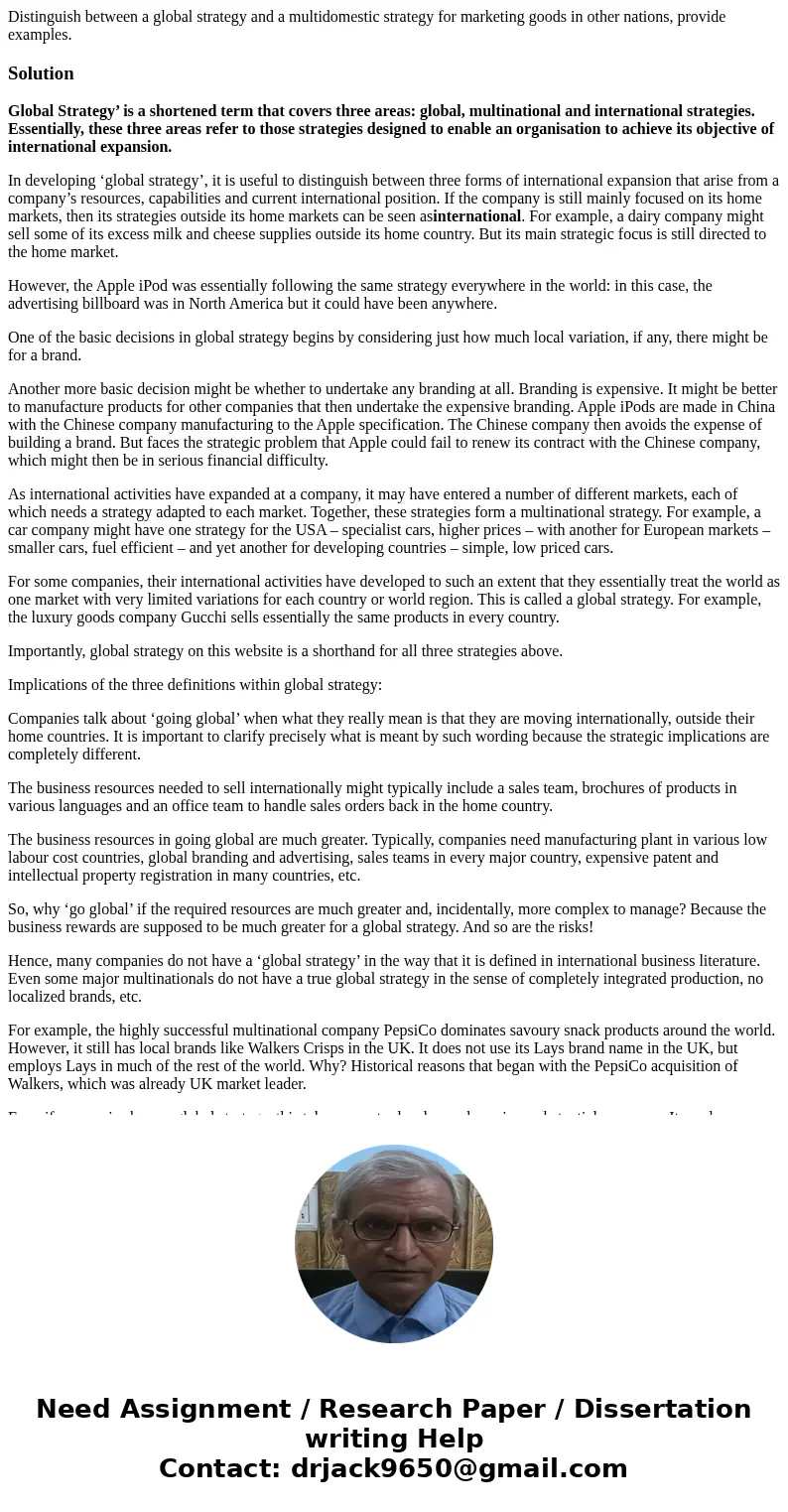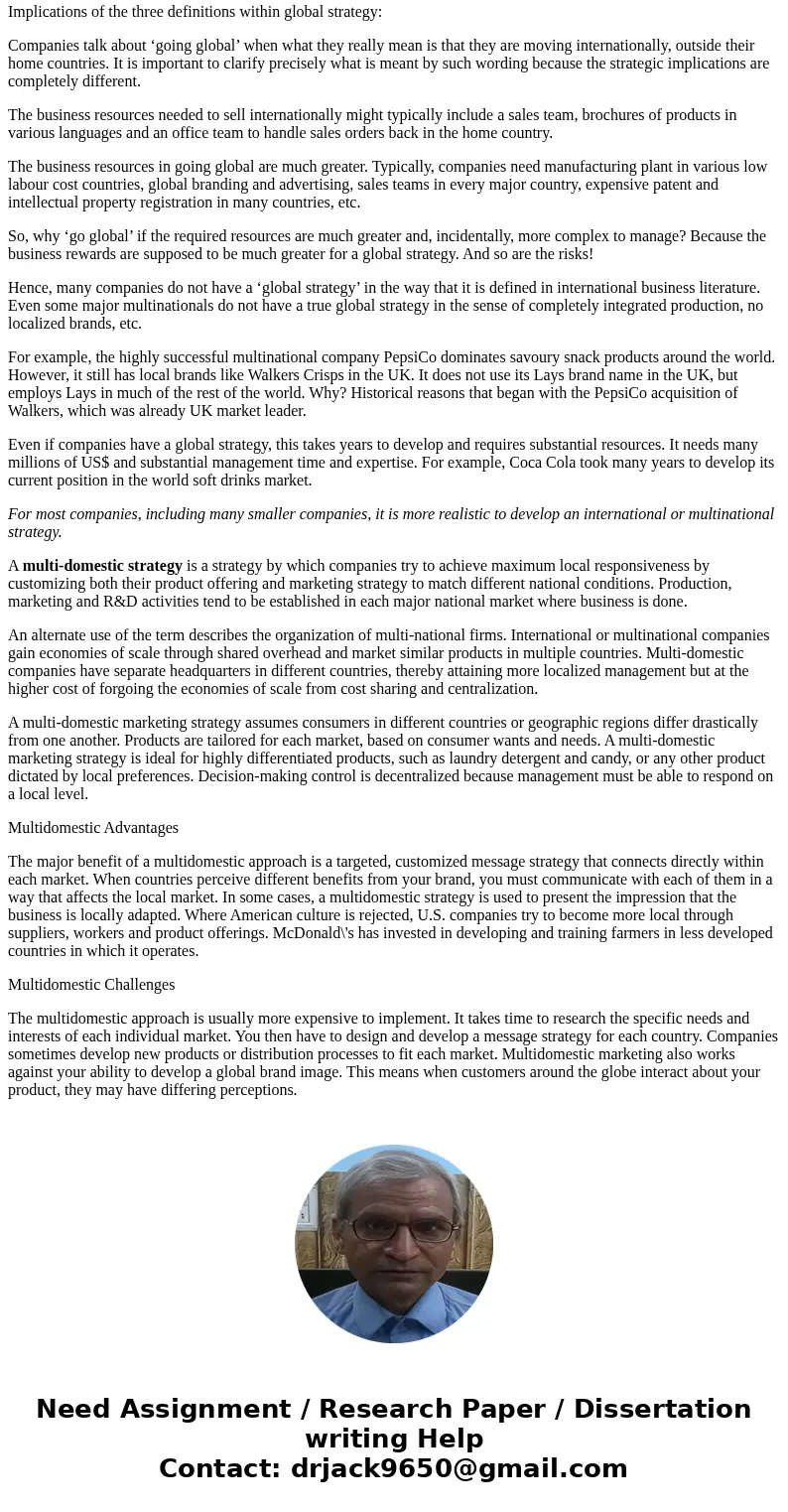Distinguish between a global strategy and a multidomestic st
Distinguish between a global strategy and a multidomestic strategy for marketing goods in other nations, provide examples.
Solution
Global Strategy’ is a shortened term that covers three areas: global, multinational and international strategies. Essentially, these three areas refer to those strategies designed to enable an organisation to achieve its objective of international expansion.
In developing ‘global strategy’, it is useful to distinguish between three forms of international expansion that arise from a company’s resources, capabilities and current international position. If the company is still mainly focused on its home markets, then its strategies outside its home markets can be seen asinternational. For example, a dairy company might sell some of its excess milk and cheese supplies outside its home country. But its main strategic focus is still directed to the home market.
However, the Apple iPod was essentially following the same strategy everywhere in the world: in this case, the advertising billboard was in North America but it could have been anywhere.
One of the basic decisions in global strategy begins by considering just how much local variation, if any, there might be for a brand.
Another more basic decision might be whether to undertake any branding at all. Branding is expensive. It might be better to manufacture products for other companies that then undertake the expensive branding. Apple iPods are made in China with the Chinese company manufacturing to the Apple specification. The Chinese company then avoids the expense of building a brand. But faces the strategic problem that Apple could fail to renew its contract with the Chinese company, which might then be in serious financial difficulty.
As international activities have expanded at a company, it may have entered a number of different markets, each of which needs a strategy adapted to each market. Together, these strategies form a multinational strategy. For example, a car company might have one strategy for the USA – specialist cars, higher prices – with another for European markets – smaller cars, fuel efficient – and yet another for developing countries – simple, low priced cars.
For some companies, their international activities have developed to such an extent that they essentially treat the world as one market with very limited variations for each country or world region. This is called a global strategy. For example, the luxury goods company Gucchi sells essentially the same products in every country.
Importantly, global strategy on this website is a shorthand for all three strategies above.
Implications of the three definitions within global strategy:
Companies talk about ‘going global’ when what they really mean is that they are moving internationally, outside their home countries. It is important to clarify precisely what is meant by such wording because the strategic implications are completely different.
The business resources needed to sell internationally might typically include a sales team, brochures of products in various languages and an office team to handle sales orders back in the home country.
The business resources in going global are much greater. Typically, companies need manufacturing plant in various low labour cost countries, global branding and advertising, sales teams in every major country, expensive patent and intellectual property registration in many countries, etc.
So, why ‘go global’ if the required resources are much greater and, incidentally, more complex to manage? Because the business rewards are supposed to be much greater for a global strategy. And so are the risks!
Hence, many companies do not have a ‘global strategy’ in the way that it is defined in international business literature. Even some major multinationals do not have a true global strategy in the sense of completely integrated production, no localized brands, etc.
For example, the highly successful multinational company PepsiCo dominates savoury snack products around the world. However, it still has local brands like Walkers Crisps in the UK. It does not use its Lays brand name in the UK, but employs Lays in much of the rest of the world. Why? Historical reasons that began with the PepsiCo acquisition of Walkers, which was already UK market leader.
Even if companies have a global strategy, this takes years to develop and requires substantial resources. It needs many millions of US$ and substantial management time and expertise. For example, Coca Cola took many years to develop its current position in the world soft drinks market.
For most companies, including many smaller companies, it is more realistic to develop an international or multinational strategy.
A multi-domestic strategy is a strategy by which companies try to achieve maximum local responsiveness by customizing both their product offering and marketing strategy to match different national conditions. Production, marketing and R&D activities tend to be established in each major national market where business is done.
An alternate use of the term describes the organization of multi-national firms. International or multinational companies gain economies of scale through shared overhead and market similar products in multiple countries. Multi-domestic companies have separate headquarters in different countries, thereby attaining more localized management but at the higher cost of forgoing the economies of scale from cost sharing and centralization.
A multi-domestic marketing strategy assumes consumers in different countries or geographic regions differ drastically from one another. Products are tailored for each market, based on consumer wants and needs. A multi-domestic marketing strategy is ideal for highly differentiated products, such as laundry detergent and candy, or any other product dictated by local preferences. Decision-making control is decentralized because management must be able to respond on a local level.
Multidomestic Advantages
The major benefit of a multidomestic approach is a targeted, customized message strategy that connects directly within each market. When countries perceive different benefits from your brand, you must communicate with each of them in a way that affects the local market. In some cases, a multidomestic strategy is used to present the impression that the business is locally adapted. Where American culture is rejected, U.S. companies try to become more local through suppliers, workers and product offerings. McDonald\'s has invested in developing and training farmers in less developed countries in which it operates.
Multidomestic Challenges
The multidomestic approach is usually more expensive to implement. It takes time to research the specific needs and interests of each individual market. You then have to design and develop a message strategy for each country. Companies sometimes develop new products or distribution processes to fit each market. Multidomestic marketing also works against your ability to develop a global brand image. This means when customers around the globe interact about your product, they may have differing perceptions.


 Homework Sourse
Homework Sourse